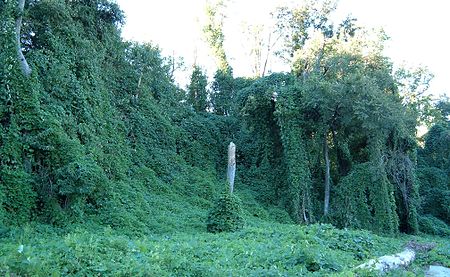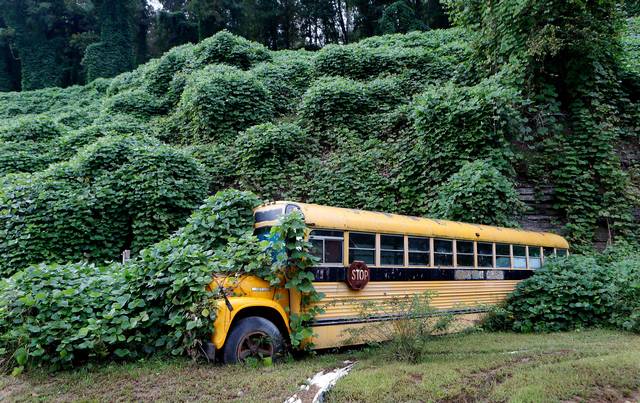
If you ask me to think about an invasive species, the first that comes to mind is the Lionfish invasion in the Caribbean. That’s probably a consequence of living in the invaded range, having had a particular interest in the subject since about 3 years ago, and having read around 300 pages of scientific articles on the topic. However, if you live anywhere in the United States South, it’s more likely you’ll think of kudzu (except maybe if you live in Florida which has a wide selection of invaders). While trying to get a background for invasive species ecology, I often came across this name, because not surprisingly, kudzu has been taken as one of the go-to text-book example of the damages an invasive species may cast upon an unaware ecosystem. That’s probably why I decided to tackle this subject; however, I’ve quickly learned that if you also shared the notion of kudzu as the prime example for invasiveness, this article might change your mind.
Know Your Enemy
Narrowing down the invader as one species, in particular, is always hard, however, the kudzu spread across the US is normally recognized as Pueraria montana (Lour.) Merr. variety lobata (Willd.). There’s probably not much variation because it’s initial introduction can easily be traced back to a historical event, The United States Centennial Exposition held in 1876 in Philadelphia, the first official US held World Fair, which among its novelties featured a bazaar housing a curious Japanese plant. The plant made a meaningful impact, especially on the Southerners, who saw this a great shade plant. And in fact, for the remainder of the 19th Century, the plant was mostly used as “an ornamental vine to shade porches and courtyards”, which in turn lead to a fine control of the plant, and the inability for the plant to root and spread.
Be Aware of Government’s Gifts
The dawn of the 20th Century brought the beginning of the problem when “innovative” farmers found out new ways to put kudzu into use, including its value as an inexpensive feed for livestock. And then came its promotion as a “wonder plant”, including strong government campaigning of kudzu in the 1930s as means to battle erosion in the South by introducing over 70 million kudzu seedlings and even granting financial enticement for each acre of kudzu planted. It’s no surprise that by 1946, there were an estimated 1.2 million acres of planted kudzu! However, its transition from wonder plant to the most hated weed in America only came through because of another event in 20th Century American history: the failure of cotton farming due to poor soils and the spread of pests, which lead to the movement of people from rural to urban areas. This lead to an unmonitored growth of kudzu, its takeover of its preferred habitats and its ingraining in Southern culture lore.
What Makes Kudzu a Good Invader?
Before we talk about whether or not kudzu has been proven to be as obnoxious as it may at first be perceived, let us talk a little bit about its biology and ecology. As I believed I have stated before on this blog, the success in settlement of an invader depends greatly on its biology, especially on its ability to quickly and easily reproduce. Kudzu is not an exception; Kudzu is able to spread so fast given to the way that it allocates its resources into extension and increase of leaf area. Once it has reached the ground, kudzu spreads its stems in all directions, and every certain distance, these stems root to the ground, forming a network of kudzu plants which may perfectly well survive and keep spreading, without the aid of other kudzu brothers (these are actually more like clones). Other adaptations that make kudzu such a suitable invader are its high photosynthetic rates (remember that they also spent a lot on leaf production), roots and rhizomes that store great amounts of water and the ability to fix atmospheric nitrogen where most plants need a symbiotic association with fungi in their roots in order to gain the precious element. We could say it’s adaptation is fast growth, and this ends up being equal to a high asexually reproductive rate.
Day of the Triffids or War of the Worlds (the radio drama that is)?

And so, it has been widely believed that kudzu was responsible for changing the landscape of the South. The stories claim that the plant stops at nothing, and if uncontrolled, it can easily go over plantations, forested areas and even urban landscapes, with stories of kudzu overgrowing houses you might believe were ripped from the pages of a science fiction story. And in fact, kudzu has set its roots in Southern culture, with poets, writers and even music groups drawing southern identity and inspiration from the weed. And with cultural presence come the unreliable myths, like the association of kudzu conglomerates with deadly snakes. You might think the best way to disprove this and other myths would be through scientific experimentation, yet it is surprising how little scientific experimental studies had been carried out regarding the plant at the time Forseth Jr and Innis wrote their review on what was scientifically known on the subject back in 2004.
There’s indeed reason for concern; going back into geological history, the Southern USA is thought to have been a refuge for a great diversity of species during the last glacial age, one last beacon where these species were able to survive, evolve, speciate and later spread once the ice age ended. So the idea of kudzu growing over natural forests, climbing to the canopy and sucking all the sunlight for himself is a grim scenario. Not only would the kudzu limit the sunlight resource, but it’s also known that vines are dangerous during storms since it just takes one tree to fall down, for it to drag its tangled neighbors down with it.
The known truth is that kudzu is indeed an economic problem since millions of dollars are spent yearly in controlling its spread, especially when it comes across railway lines or service poles like electrical or telephone wires. However, its magnitude is now believed to have been drawn out of proportion, with the US Forest Service reporting that kudzu covers less than 1% of the total forest area of the South and that invasive roses cover three times more land than kudzu. The reason behind this exaggeration of the threat can be traced to the plant’s preferred habitat. It turns out that kudzu thrives in open spaces, such as abandoned plantations, roadsides, and forest edges, so although it would rarely penetrate into the depth of the woods, it’s likely that most people have witnessed it on its favored surroundings.

There are however reasons on why kudzu still shouldn’t be taken lightly. It has been proven that the plant has the potential to alter the biogeochemical cycles which basically regulate and run the ecosystems, through an increase of nitrogen being fixed in the ground. As essential as nitrogen is, its saturation can quickly lead to loss of soil fertility as well as pollution of nearby bodies of water. Kudzu has also been proved to be an intermediate to high isoprene emitter, which is considered to be an air pollutant. Plus, kudzu has even found its way into some nature reserves and national parks, forcing managers to spent great amounts of money with differing results in order to control and try to eradicate a plant which visitors might find diminishes their experience of visiting a protected area.
Mowing the Kudzu Lawn
This being said, control has proven to be difficult, with the first efforts dating to the 1950s. Herbicides can be used, and potential natural control agents have been found aplenty. Some of these pests, which also tend to be introduced, are seed and leaf eaters, though they show a higher preference for a related Asian plant, the soybean. Fungal and bacterial pathogens have also been identified, but these former are poisonous to mammals and the latter didn’t cause plant death. The most effective method, though labor intensive, has proven to be the trimming of the plants before Fall season, when the plants move their resources back to their roots. If done with the right timing, this should greatly weaken the plant for the next year. The process should be repeated for 3-4 years for it to eliminate a population.
References
Blaustein RJ. 2001. Kudzu’s invasion into Souther United States life and culture. In: McNeeley JA ed. The Great Reshuffling: Human Dimensions of Invasive Species. IUCN, Gland, Switzerland and Cambridge, UK. The World Conservation Union: 55-62
Finch B. 2015. The True Story of Kudzu, The Vine That Never Truly Ate the South. Smithsonian Magazine. Consulted online
Forseth Jr IN, Iniis AF. 2004. Kudzu (Pueraria montana): History, Physiology, and Ecology Combine to Make a Major Ecosystem Threat. Critical Reviews in Plant Sciences 23(5): 401-413